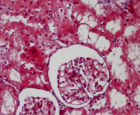Abstract
Research Article
Impact of amitriptyline on learning and memory
Mfem CC and Seriki SA*
Published: 14 April, 2021 | Volume 5 - Issue 1 | Pages: 009-015
Background/aim: Amitriptyline belongs to class of known as tricycline antidepresant (TCA) that is being used to treat anxiety and depressive states. It may help improve mood and feelings of well-being, relieve anxiety and tension, help to improve sleep and increase energy level. The study investigated the effect of amitriptyline on learning and memory using eighteen (18) healthy Swiss mice of both sexes weighing 16 – 25 g.
Method: The animals were divided into three (3) groups consisting of six (6) animals each. Group 1 served as the control group, Group 2 was administered with amitriptyline at a dose of 3 mg/kg body weight dissolved in 3 mls of distilled water, and used to test for learning, while Group three was also given similar administration like Group 2, but used to test for memory. All the animals were tested for learning and memory performance using Novel object recognition task and Morris water maze test.
Results: The results obtained from the Novel object recognition task showed that there was a significant decrease (p < 0.05) in total object approach in acquisition trial of amitriptyline treated group when compared to the acquisition trial of the control group. There was a significant decrease (p < 0.05) in retention trial of amitriptyline group when compared to retention trial in the control group. There was a significant decrease (p < 0.05) in total duration exploring objects in acquisition trial of amitriptyline treated group when compared to the acquisition trial of the control group. There was a significant increase (p < 0.05) in total duration exploring objects in retention trial of amitriptyline treated group when compared to the retention trial of the control group. There was a significant decrease (p < 0.05) in the index of habituation of amitriptyline treated group when compared to the control group. The index of discrimination showed a significant increase (p < 0.05) in amitriptyline treated group when compared to the control group and a significant decrease (p < 0.05) in amitriptyline group when compared to the control group. In the Morris water maze test, Day 1 – 3 were for acquisition training, day 4 – 6 reversal training, day 7 the probe trial day and day 8 the visible platform day. During acquisition training in the Morris water maze test, there was no significant difference in Swim latencies in day 1 and 2. However in day 3, there was a significant increase (p < 0.05) in swim latency of group compared to control group and a significant decrease (p < 0.05) in swim latency of amitriptyline treated group compared to the control group. During reversal training in day 1, 2 and 3, there was no significant difference in swim latency among the three groups. Results for the retention quadrant in the probe trials showed a significant decrease (p < 0.01) in amitriptyline group when compared to the control group.
Conclusion: Results suggest that amitriptyline impairs learning and memory functions.
Read Full Article HTML DOI: 10.29328/journal.ida.1001025 Cite this Article Read Full Article PDF
Keywords:
Amitriptyline; Learning and memory; Antidepressant; Sleep
References
- Atkinson RC, Shiffrin RM. Chapter: Human Memory: A proposed system and its control processes. In Spence, K. W.; Spenc J. T. The psychology of learning and motivation 2 New York Academic Press. 1968; 89-105.
- Eysenck A. Fundamentals of cognition. New York: Psychology Press 2007; 16-19
- Baddely A. Working memory, thought and action. Oxford, UK: Oxford University Press 2007; 30-35.
- Spear NE, Riccio DC. Memory: Phenomena and principles. Allyn and Bacconprintrs. 1994; 15-17.
- Montenegro M, Veiga H, Deslandes A. Nuromodulatory effects of caffeine and bromazepam on visual event-related potential (P300): a comparative study. Arq Neuropsiquiaatr. 2005; 63: 410-415. PubMed: https://pubmed.ncbi.nlm.nih.gov/16059590/
- Cunha M, Portela C, Bastos VH. Responsiveness of sensorimotor cortex during pharmacological intervention with bromazepam Neuroscience Letter 2008; 448: 33-36. PubMed: https://pubmed.ncbi.nlm.nih.gov/18938214/
- Zola M, Suire LR. Neuroantomy of memory. Ann Neurosci. 1993; 16: 547-563. PubMed: https://pubmed.ncbi.nlm.nih.gov/8460903/
- Kaplan SA, Jack ML, Weinfeld RE, Glover W, Weissman L, et al. Biopharmaceutical and clinical pharmacokinetic profile of bromazepam. J Phamacokinet Biopharm 2008; 4: 1-16. PubMed: https://pubmed.ncbi.nlm.nih.gov/5586/
- Graeff FG. Drogas psicotrópicas e seu modo de ação. 2.Ed. São Paulo: EPU, 1989.
- Katzung BG. Basic clinical pharmacology. 6.Ed. London: Pretence-Hall, 1995; 40-47.
- Oelschlager H. Chemical and pharmacologic aspects of benzodiazepines. Schweiz Rundsch Med Prax. 1989; 78: 766-772. PubMed: https://pubmed.ncbi.nlm.nih.gov/2570451/
- Ennaceur A. One-trial object recognition in rats and mice: methodological and theoretical issues. Behav Brain Ress. 2010; 215: 244-254. PubMed: https://pubmed.ncbi.nlm.nih.gov/20060020/
- Kopp C, Rudolph U, Low K, Tobler I. Modulation of rhythmic brain activity by diazepam: GABA (A) receptor subtype and state specificity. Proc Natl Acad Sci USA. 2004; 101: 3674-3679. PubMed: https://pubmed.ncbi.nlm.nih.gov/14990800/
- Hobi V, Dubach UC, Skreta M, Forgo I, Riggenbach H. The subacute effect of bromazepam on psychomotor activity and subjective mood. J Intern Med Res. 1982; 10: 140-146. PubMed: https://pubmed.ncbi.nlm.nih.gov/6124470/
- Jansen AAI, Verbaten MN, Slangen JL. Acute effects of bromazepam on signal detection performance digit symbol substitution test and smooth pursuit eye movement. Nueropsychobiol. 1988; 20: 91-95. PubMed: https://pubmed.ncbi.nlm.nih.gov/2908134/
- Heloisa VD, Andrea CD, Kaleb MC, Fernando AM. Neuromodulatory effects of caffeine and bromazepam on visual event related potential (P300): A comparative study. Arq Neuropsiquatar. 2005; 63: 410-415. PubMed: https://pubmed.ncbi.nlm.nih.gov/16059590/
- Bourin M, Auget JL, Colombel MC, Larousse C. Effects of single oral doses of bromazepam, buspirone and clobazam on performance tasks and memory. Pharmacopsych. 1989; 22: 141-145. PubMed: https://pubmed.ncbi.nlm.nih.gov/2577220/
- Koelega HS. Benzodiazepines and vigilance performance: a review. Psychopharmacology. 1989; 98: 145-156. PubMed: https://pubmed.ncbi.nlm.nih.gov/2569213/
- Van Leeuwen TH, Verbaten MN, Koelega HS, Kenemans JL, Slangen JL. Effects of bromazepam on single-trial event-related potentials in a visual vigilance task. Psychopharmacol 1992; 106: 555-564. PubMed: https://pubmed.ncbi.nlm.nih.gov/1579628/
- Polich J. P300 in clinical applications. In Niedermeyer E, Lopes da Silva F. (eds). Electroencephalography: basic principles, clinical applications and related fields. 4 Ed. Baltimore: Urban & Schwarzenberg. 1999: 1073-1091.
- Matthews A, Kirkby KC, Martin F. The effects of single-dose lorazepam on the memory and behavioural learning. J Psychopharmacol. 2002; 16: 345-354. PubMed: https://pubmed.ncbi.nlm.nih.gov/12503834/
- Hayakkawa T, Uchiyama M, Urata J. Effects of small dose of triazolam on P300. Psychiatry Clin Neurosci. 1999; 53: 185-187. PubMed: https://pubmed.ncbi.nlm.nih.gov/10459684/
- Richard EB, Lianne S, Heather M. Developing standardized behavioural tests for knockout and mutant mice. ILAR J. 2000; 41: 163-174. PubMed: https://pubmed.ncbi.nlm.nih.gov/11406708/
- Paylor R, Baskall-Baldini L, Yuva L, Wehner JM. Developmental differences in place-learning performance between C57BL/6 and DBA/2 mice parallel the ontogeny of hippocampal protein kinase C. Behavio Neurosci. 1996; 110: 1415-1425. PubMed: https://pubmed.ncbi.nlm.nih.gov/8986342/
- Authier N, Balayssac D, Sautereau M, Zangarelli A. Benzodiazepine dependence: focus on withdrawal syndrome. Ann Pharm Fr. 2009; 67: 408-413. PubMed: https://pubmed.ncbi.nlm.nih.gov/19900604/
- Liljequist R, Linnoila M, Mattila MJ, Saario I. Effect of two weeks’ treatment with thioridazine, chlorpromazine, sulphiride and bromazepam, alone or in combination with alcohol, on learning and memory in man. Psychopharmacologia. 1975; 44205-4208. PubMed: https://pubmed.ncbi.nlm.nih.gov/710/
- Umaharan T, Sivayokan S, Sivansuthan S. Amitriptyline Dependence and Its Associations: A Case Report and Literature. Review Case Rep Psychiatry. 2021; 2021: 6647952. PubMed: https://pubmed.ncbi.nlm.nih.gov/33564485/
Figures:

Figure 1

Figure 2

Figure 3

Figure 4

Figure 5

Figure 6

Figure 7

Figure 8
Similar Articles
-
Multi-factorial Depressive Disorders Need Multi-dimensional InterventionsMustafa Melih Bilgi*. Multi-factorial Depressive Disorders Need Multi-dimensional Interventions. . 2017 doi: 10.29328/journal.hda.1001002; 1: 012-014
-
Sleeplessness and healthSunitha V,Jeyastri Kurushev,Felicia Chitra,Manjubala Dash*. Sleeplessness and health. . 2019 doi: 10.29328/journal.ida.1001010; 3: 001-007
-
Problems shared in psychiatry helpline of a teaching hospital in eastern Nepal during COVID-19 pandemic lockdownDhana Ratna Shakya*. Problems shared in psychiatry helpline of a teaching hospital in eastern Nepal during COVID-19 pandemic lockdown. . 2020 doi: 10.29328/journal.ida.1001017; 4: 037-039
-
Hormones and depression in womenJohn Studd*. Hormones and depression in women. . 2020 doi: 10.29328/journal.ida.1001022; 4: 064-065
-
Impact of amitriptyline on learning and memoryMfem CC,Seriki SA*. Impact of amitriptyline on learning and memory. . 2021 doi: 10.29328/journal.ida.1001025; 5: 009-015
-
Observation of telepsychiatry service in a teaching hospital of eastern Nepal during COVID-19 pandemicDhana Ratna Shakya*. Observation of telepsychiatry service in a teaching hospital of eastern Nepal during COVID-19 pandemic. . 2021 doi: 10.29328/journal.ida.1001027; 5: 025-028
Recently Viewed
-
A Resurgence of the Idea of Hypertriglyceridemia and Lower Serum (HDL-C) as Predictive Factors for Insulin Resistance (IR) & Type 2 Diabetes Mellitus Development: A Narrative ReviewKulvinder Kochar Kaur*. A Resurgence of the Idea of Hypertriglyceridemia and Lower Serum (HDL-C) as Predictive Factors for Insulin Resistance (IR) & Type 2 Diabetes Mellitus Development: A Narrative Review. New Insights Obes Gene Beyond. 2025: doi: 10.29328/journal.niogb.1001022; 9: 001-012
-
Novel Mutation in Famous Gene Diseases in Red Blood CellsMahdi Nowroozi*. Novel Mutation in Famous Gene Diseases in Red Blood Cells. New Insights Obes Gene Beyond. 2025: doi: 10.29328/journal.niogb.1001023; 9: 013-020
-
Physical Performance in the Overweight/Obesity Children Evaluation and RehabilitationCristina Popescu, Mircea-Sebastian Șerbănescu, Gigi Calin*, Magdalena Rodica Trăistaru. Physical Performance in the Overweight/Obesity Children Evaluation and Rehabilitation. Ann Clin Endocrinol Metabol. 2024: doi: 10.29328/journal.acem.1001030; 8: 004-012
-
The Role of Genetic Mutations in the HPGD & SLCO2A1 Genes in Pachydermoperiostosis SyndromeShahin Asadi*,Arezo Zare,Sima Koohestani. The Role of Genetic Mutations in the HPGD & SLCO2A1 Genes in Pachydermoperiostosis Syndrome. J Genet Med Gene Ther. 2025: doi: 10.29328/journal.jgmgt.1001013; 8: 001-005
-
Estimation of Radiation Dose to Blood Vessels and Components from Medical Imaging Procedures: Current StatusKhalid M Aloufi*. Estimation of Radiation Dose to Blood Vessels and Components from Medical Imaging Procedures: Current Status. Arch Vas Med. 2025: doi: 10.29328/journal.avm.1001020; 9: 001-002
Most Viewed
-
Causal Link between Human Blood Metabolites and Asthma: An Investigation Using Mendelian RandomizationYong-Qing Zhu, Xiao-Yan Meng, Jing-Hua Yang*. Causal Link between Human Blood Metabolites and Asthma: An Investigation Using Mendelian Randomization. Arch Asthma Allergy Immunol. 2023 doi: 10.29328/journal.aaai.1001032; 7: 012-022
-
Impact of Latex Sensitization on Asthma and Rhinitis Progression: A Study at Abidjan-Cocody University Hospital - Côte d’Ivoire (Progression of Asthma and Rhinitis related to Latex Sensitization)Dasse Sery Romuald*, KL Siransy, N Koffi, RO Yeboah, EK Nguessan, HA Adou, VP Goran-Kouacou, AU Assi, JY Seri, S Moussa, D Oura, CL Memel, H Koya, E Atoukoula. Impact of Latex Sensitization on Asthma and Rhinitis Progression: A Study at Abidjan-Cocody University Hospital - Côte d’Ivoire (Progression of Asthma and Rhinitis related to Latex Sensitization). Arch Asthma Allergy Immunol. 2024 doi: 10.29328/journal.aaai.1001035; 8: 007-012
-
An algorithm to safely manage oral food challenge in an office-based setting for children with multiple food allergiesNathalie Cottel,Aïcha Dieme,Véronique Orcel,Yannick Chantran,Mélisande Bourgoin-Heck,Jocelyne Just. An algorithm to safely manage oral food challenge in an office-based setting for children with multiple food allergies. Arch Asthma Allergy Immunol. 2021 doi: 10.29328/journal.aaai.1001027; 5: 030-037
-
Snow white: an allergic girl?Oreste Vittore Brenna*. Snow white: an allergic girl?. Arch Asthma Allergy Immunol. 2022 doi: 10.29328/journal.aaai.1001029; 6: 001-002
-
Cytokine intoxication as a model of cell apoptosis and predict of schizophrenia - like affective disordersElena Viktorovna Drozdova*. Cytokine intoxication as a model of cell apoptosis and predict of schizophrenia - like affective disorders. Arch Asthma Allergy Immunol. 2021 doi: 10.29328/journal.aaai.1001028; 5: 038-040

If you are already a member of our network and need to keep track of any developments regarding a question you have already submitted, click "take me to my Query."


















































































































































